BECCS: Bioenergy with Carbon Capture and Storage
6 minute read
Updated on: 26 Jul 2021

Plants and trees can capture CO₂ from the air at a low cost. But after a few decades, forests run out of storage capacity. And when the plants die, most of their carbon is re-emitted back into the atmosphere . How can we get around this problem? One possible solution is bioenergy with carbon capture and storage (BECCS).
Biomass is any matter from plants, animals, or other living things. We call it biofuel if we can use it to make energy, and call that energy bioenergy .
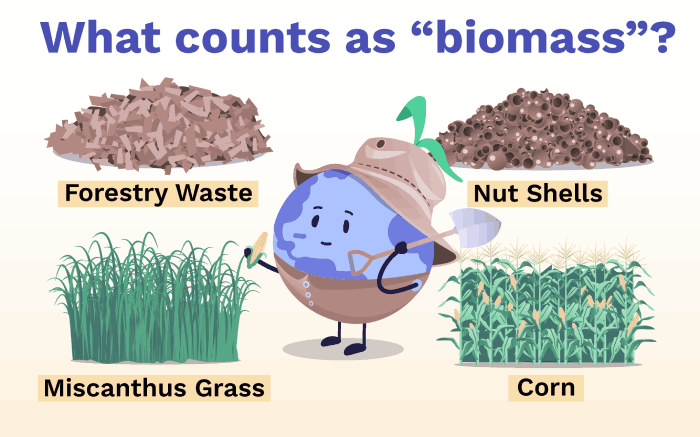
Examples of different types of biomass.
What is Bioenergy with Carbon Capture and Storage?
Plant biomass can be burnt to release its energy as heat directly, or it can be fermented into an alcohol (which can later be burnt to provide energy). Both of these produce CO₂, which must therefore be captured and then stored .
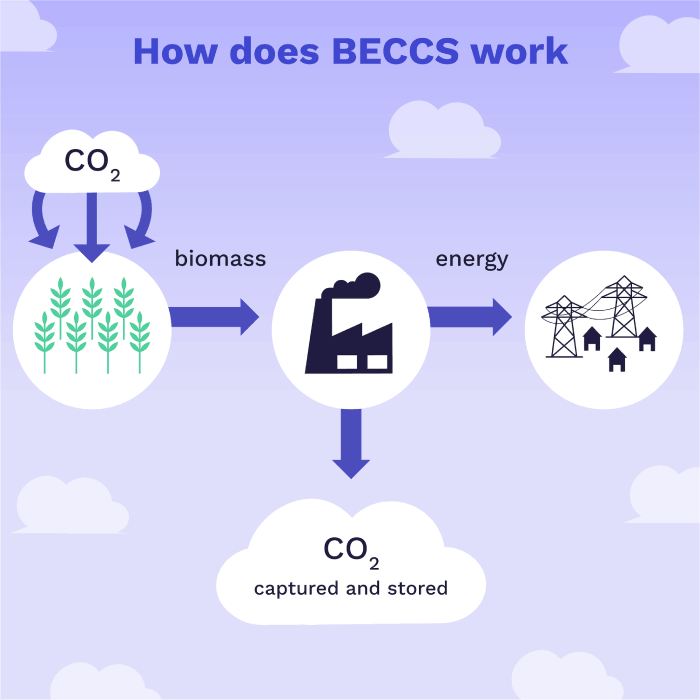
Process of BECCS
Biomass-fired power plants are built to include a method to capture CO₂. This usually means capturing the high-concentration CO₂ that leaves the power plant through the flue chimney
.
Alternatively, biomass can be fermented with yeast or bacteria to produce biofuels such as ethanol . CO₂ released is released during fermentation but can be captured
. This fuel could be used in places where effective carbon capture isn’t possible, such as car or airplane engines
.
What are the environmental impacts of BECCS?
Growing crops for bioenergy uses a lot of land: for every gigatonne of CO2 absorbed, 320-580 thousand km² of land are needed!
If more land is needed to grow biofuel crops, this could lead to deforestation as trees are cut down to make room for farming. This would cause habitat loss as well as the release of CO₂ from cut-down trees and disturbed soil - the opposite of what we want! .
Growing crops for BECCS would also use artificial fertilisers, along with lots of water .
Global agriculture already accounts for over 70% of freshwater use , so increasing this number for BECCS is no small feat!
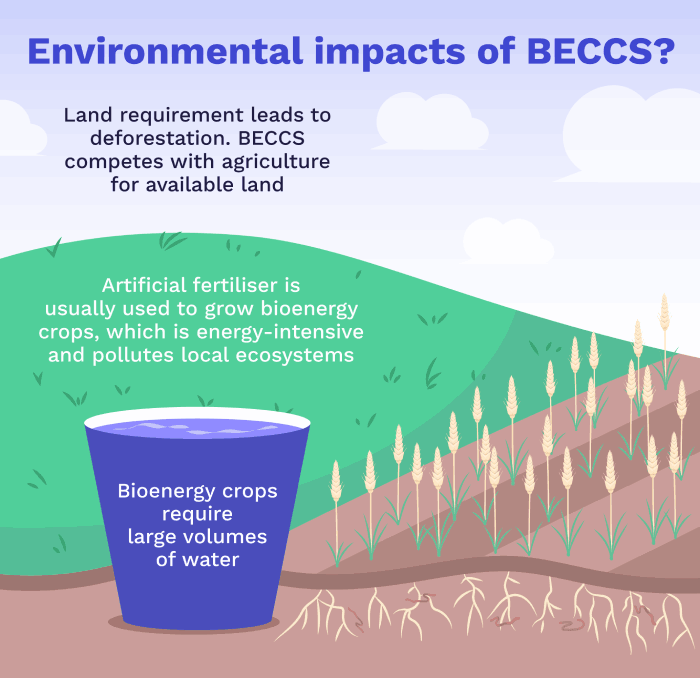
Environmental impacts of farming for BECCS
What are the political and social effects?
Using land for energy production means less land for food production . Because these two compete for land, we tend to see higher food prices when more biofuels are used
. In fact, in 2008, the recent increase in biofuel use was estimated to be partly responsible for a 30% increase in the price of grain worldwide
.
Increasing prices can cause conflict, too, as seen during riots in Mexico in 2007. These were triggered when corn grown in the US was used for biofuels instead of going to Mexico as food .
Another problem is that competition for land can lead to land grabbing, where companies buy large areas of land and take it away from local people .
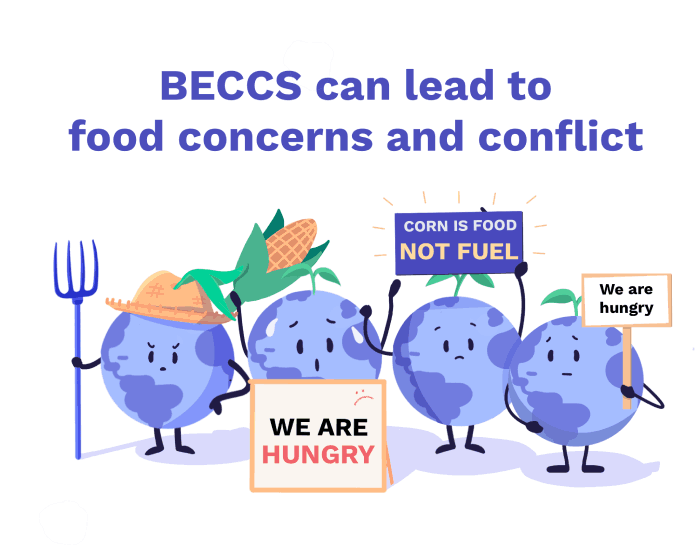
Social impacts of BECCS
On the other hand, producing biofuels can be good for a country’s economy - even more so than producing fossil fuels ! In Brazil, producing biofuels from sugarcane provides six times more jobs than the Brazilian petrol sector
, and the average workers’ income is higher than in nearly all other agricultural sectors
.
Biofuel production may also increase local energy security and access to energy .
How much will it cost?
Estimates of costs range between US$15-400 per tonne of CO₂ avoided, depending on exactly how energy is produced from the biomass .
Some costs could be reduced through economies of scale, where the more produced, the lower the price. Transport costs could be reduced by compacting biomass into small, dense pellets or by growing biomass near existing industrial sites .
The most likely price by 2050 is probably between US$100-$200 per tonne of CO₂ avoided .
How much CO₂ can BECCS remove?
The maximum potential of BECCS could be as high as 77 GtCO₂ /year if all available marginal and abandoned land is used to grow biofuels . If only waste biomass is used, the maximum is 5.2 GtCO₂/year
.
However, unless we were to only use waste biomass feedstocks, BECCS would push ecosystems and water use to their limits. What’s more, the above estimate is a maximum theoretical value for carbon sequestration: a more realistic value is between 0.5–5 GtCO₂ .
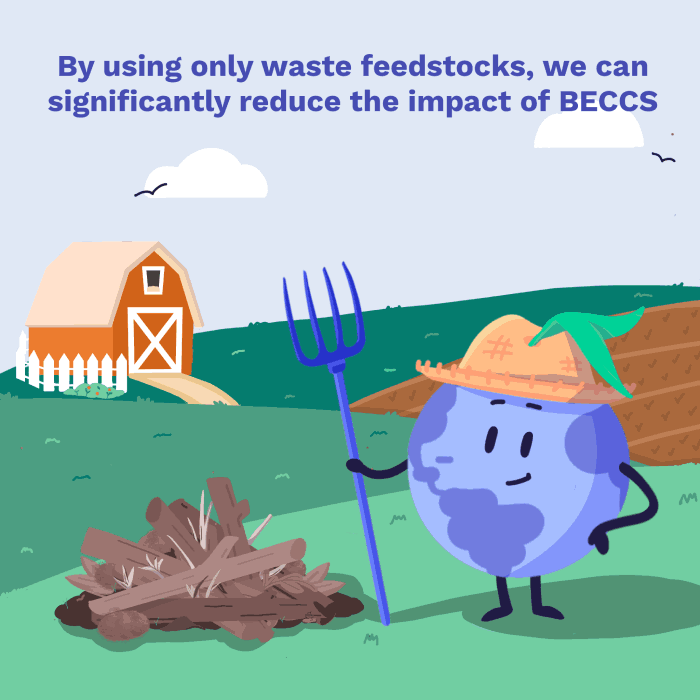
Using waste feedstocks reduces BECCS’s impact
Many people expect BECCS to become an essential tool for removing CO₂ from the atmosphere, thanks to its benefits as an energy source. However, we know that growing new biomass can impact land availability, water, and biodiversity. If we do start to use BECCS on a large scale, it will be important to address these issues.
So far, we have looked at methods that exploit natural processes to remove carbon dioxide from the atmosphere. But what if we could use machines to remove it from the air directly?
Next Chapter